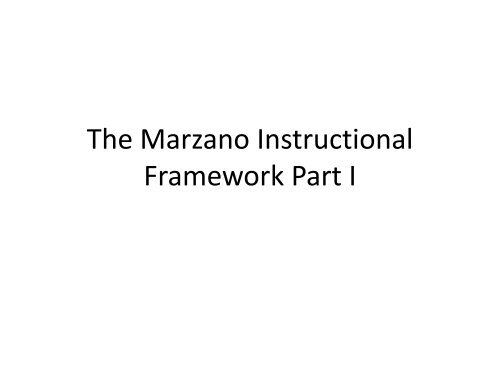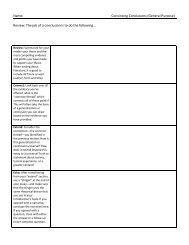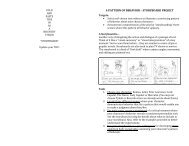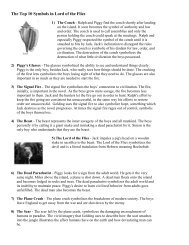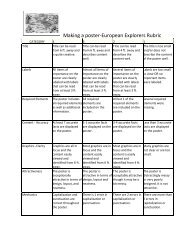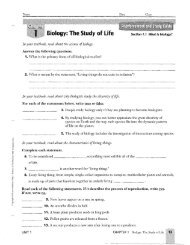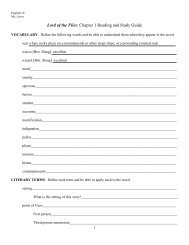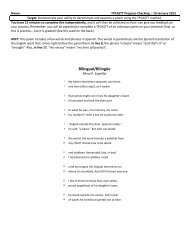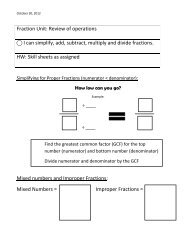The Marzano Instructional Framework Part I Slides
The Marzano Instructional Framework Part I Slides
The Marzano Instructional Framework Part I Slides
You also want an ePaper? Increase the reach of your titles
YUMPU automatically turns print PDFs into web optimized ePapers that Google loves.
<strong>The</strong> <strong>Marzano</strong> <strong>Instructional</strong><br />
<strong>Framework</strong> <strong>Part</strong> I
<strong>Instructional</strong> <strong>Framework</strong> <strong>Part</strong> I<br />
Learning Targets<br />
• Begin to establish a common language for T & L<br />
through instructional framework<br />
• Develop an understanding of the connections<br />
between <strong>Marzano</strong>’s <strong>Framework</strong> to the State<br />
Criteria<br />
• Develop an understanding of Domain 1:<br />
Classroom Strategies & Behaviors<br />
– Routine, Content Specific, Enacted on the Spot
Digging in Routine Lesson Segments<br />
Review the teacher scales for this segment<br />
• “Mmm-hmm” statement<br />
• “Aha”statement<br />
• “Huh?” question<br />
1.1 Providing clear learning goals and scales<br />
1.2 Celebrating success<br />
1.3 Understanding students’ interests and backgrounds<br />
5.1 Organizing the physical layout of the classroom<br />
5.2 Acknowledging adherence to rules and procedures
Digging in Routine Lesson Segments<br />
Activity 1: Learning Goals<br />
Learning Targets Scale not<br />
Required<br />
Learning Goals Scale<br />
Required
Digging in Routine Lesson Segments<br />
Activity 1: Learning Goals<br />
Look through pages 1 – 6, identify 1 new<br />
learning to share
Digging in Routine Lesson Segments<br />
Activity 2: Scales<br />
Explore the website
Review Routine Lesson Segments<br />
1.1 Providing clear learning goals and scales<br />
1.2 Celebrating success<br />
1.3 Understanding students’ interests and<br />
backgrounds<br />
5.1 Organizing the physical layout of the<br />
classroom<br />
5.2 Acknowledging adherence to rules and<br />
procedures
Criteria<br />
Review Routine Lesson Segments<br />
1. Centering instruction on high expectations<br />
5. Fostering a safe, positive learning<br />
environment
Digging in Content Segments<br />
Review the teacher scales for this segment<br />
• “Mmm-hmm” statement<br />
• “Aha”statement<br />
• “Huh?” question<br />
2.1 Interacting with new knowledge<br />
2.2 Organizing students to practice and deepen<br />
knowledge<br />
2.3 Organizing students for cognitively complex tasks<br />
2.7 Using and applying academic vocabulary
Digging in Content Segments<br />
Activity 1: Exploring the Action Steps<br />
Look through the Action Steps for practicing and<br />
deepening students understanding. Find a<br />
strategy that’s worked for you or you’re<br />
interested in.<br />
• Review the scale & talk in your group about<br />
what works.<br />
• What would you tell a first year teacher about<br />
this Action Step?
Digging in Content Segments<br />
Activity 2: Video Observation – which scale<br />
stood out?<br />
2.1 Interacting with new<br />
knowledge<br />
2.2 Organizing students to<br />
practice and deepen<br />
knowledge<br />
2.3 Organizing students for<br />
cognitively complex<br />
tasks<br />
2.7 Using and applying<br />
academic vocabulary
Review Content Segments<br />
2.1 Interacting with new knowledge<br />
2.2 Organizing students to practice and deepen<br />
knowledge<br />
2.3 Organizing students for cognitively complex<br />
tasks<br />
2.7 Using and applying academic vocabulary
Criterion 2<br />
Review Content Segments<br />
2. Demonstrating effective teaching practices
Digging in Enacted on the Spot<br />
Review the teacher scales for this segment<br />
• “Mmm-hmm” statement<br />
• “Aha”statement<br />
• “Huh?” question<br />
1.3 Understanding students’ interests and backgrounds<br />
1.4 Demonstrating value and respect for low expectancy students<br />
2.4 Asking questions of low expectancy students<br />
2.5 Probing incorrect answers with low expectancy students<br />
2.6 Noticing when students are not engaged<br />
5.3 Demonstrating ‘withitness’<br />
5.4 Applying consequences for lack of adherence to rules and procedures<br />
5.5 Acknowledging adherence to rules and procedures<br />
5.6 Displaying objectivity and control
Digging in Enacted on the Spot<br />
Segments<br />
Activity 1: Reflect & Share<br />
Review the past couple of days and your teaching –<br />
what kinds of on the spot decisions have you made?<br />
List at least 5<br />
Which components from the Teacher Scales connect to<br />
those decision?<br />
What supports effective decision making during<br />
enacted on the spot opportunities?
Review Enacted on the Spot<br />
1.3 Understanding students’ interests and backgrounds<br />
1.4 Demonstrating value and respect for low expectancy<br />
students<br />
2.4 Asking questions of low expectancy students<br />
2.5 Probing incorrect answers with low expectancy students<br />
2.6 Noticing when students are not engaged<br />
5.3 Demonstrating ‘withitness’<br />
5.4 Applying consequences for lack of adherence to rules and<br />
procedures<br />
5.5 Acknowledging adherence to rules and procedures<br />
5.6 Displaying objectivity and control
Criteria<br />
Review Enacted on the Spot<br />
2. Demonstrating effective teaching practices<br />
5. Fostering a safe, positive learning<br />
environment
<strong>Instructional</strong> <strong>Framework</strong> <strong>Part</strong> I<br />
Learning Targets<br />
• Begin to establish a common language for T & L<br />
through instructional framework<br />
• Develop an understanding of the connections<br />
between <strong>Marzano</strong>’s <strong>Framework</strong> to the State<br />
Criteria<br />
• Develop an understanding of Domain 1:<br />
Classroom Strategies & Behaviors<br />
– Routine, Content Specific, Enacted on the Spot
Reflection<br />
• Quiz<br />
• Survey Feedback


